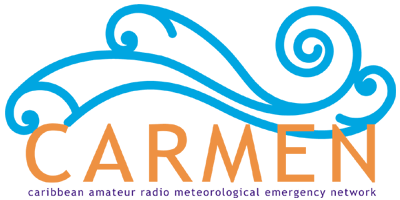
Caribbean Amateur Radio Meteorological Emergency Network

Volunteer amateur radio operators (Hams), have maintained a radio station WX4NHC at the National Hurricane Center (NHC) in Miami since 1980. During each hurricane season, whenever a hurricane is approaching land, they have collected hundreds of supplemental surface weather reports from hams in and around the Caribbean. These reports from Hams who possess a home weather station have helped the hurricane forecasters refine and improve the forecasts that they produce. NHC also receive weather data from “official” sites in the area such as local airports. However, when a storm is approaching many of these airports close down, personnel go home and important weather data is not available.
A method to increase the number of surface reports from the affected area was needed, and so the Caribbean Amateur Radio Meteorological Emergency Network or CARMEN was created. WX4NHC working in cooperation with the International Activities office of NOAA developed a plan. Weather stations would be provided and installed at the QTH of selected hams on each island, the number of units would be determined from the size and geography of each island. Each station had to have 20meter SSB capability together with suitable standby power.
A pilot project, phase 1, was implemented in late1999 and focused on the northern Lesser Antilles. Twenty Peet Bros. U2000 weather systems were installed on the Netherlands Antilles (6) (Islands of St. Maarten, Saba, and St. Eustatius), Antigua/Barbuda (5), Anguilla (4). St Kitts and Nevis (5). During the hurricane season of 2000 some of these stations were put to the test and provided valuable data to the forecasters. Phase 2 expanded the network to four additional countries with 35 Davis Instruments stations. Installation and check-out of the equipment for the Bahamas (15), Dominican Republic (5), Belize (5) and Guatemala (10) has started and should be complete before the 2001 hurricane season
All of these stations are manual, in that the operator takes a reading and then sends it to NHC either by radio, Internet or fax. The Amateur Radio Coordinator at NHC has been working with NOAA with the idea of making the reporting stations automatic using APRS. The weather data from several locations on and around a larger island would be sent on 2m VHF to a collection point and then when a storm is imminent the data would be “gatewayed” onto HF for transmission to NHC in Miami. This has been demonstrated by tests conducted by KU4GY and PJ6DM, Don on the island of Saba ( 20 miles SW of St. Maarten).
Working with the Florida Solar Energy Center we have developed and tested two prototype stand-alone APRS units. This approach will allow the operators more time to secure their homes and family and they could be placed in critical locations that are usually evacuated when a storm is approaching. The ultimate goal is to install a large number of weather stations dispersed across the region, all connected via APRS and automatically sending important weather data to WX4NHC at NHC.
![]()